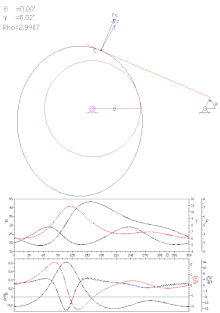
Back Nok Afrikaans حدبة Arabic Lleva Catalan Vačka Czech Kam (mekanik) Danish Kurvenscheibe German Leva (mecánica) Spanish Nukkmehhanism Estonian Espeka Basque بادامک Persian


A cam is a rotating or sliding piece in a mechanical linkage used especially in transforming rotary motion into linear motion.[1][2] It is often a part of a rotating wheel (e.g. an eccentric wheel) or shaft (e.g. a cylinder with an irregular shape) that strikes a lever at one or more points on its circular path. The cam can be a simple tooth, as is used to deliver pulses of power to a steam hammer, for example, or an eccentric disc or other shape that produces a smooth reciprocating (back and forth) motion in the follower, which is a lever making contact with the cam. A cam timer is similar, and were widely used for electric machine control (an electromechanical timer in a washing machine being a common example) before the advent of inexpensive electronics, microcontrollers, integrated circuits, programmable logic controllers and digital control.
- ^ "cam definition". Merriam Webster. Retrieved 2010-04-05.
a rotating or sliding piece (as an eccentric wheel or a cylinder with an irregular shape) in a mechanical linkage used especially in transforming rotary motion into reciprocating motion or vice versa
- ^ Shigley, J.; Uicker, J. (2010). Cam Design. Theory of Machines and Mechanisms (4 ed.). Oxford University Press, USA. p. 200.